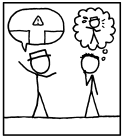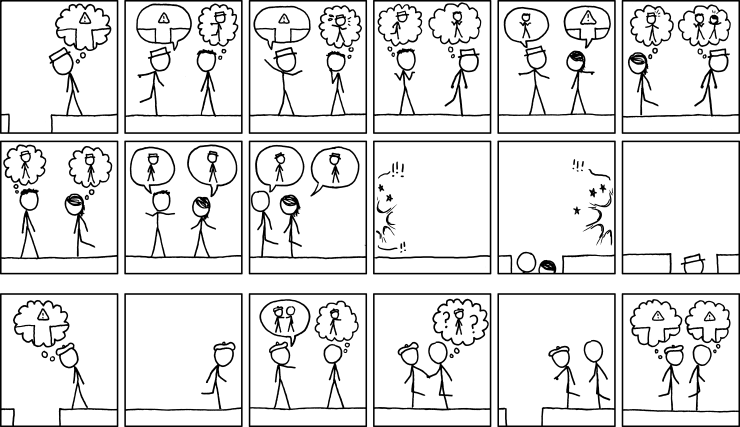A non-mathematical theory of communication
« previous post | next post »
 According to Claude Shannon, "A Mathematical Theory of Communication", Bell System Technical Journal 1948:
According to Claude Shannon, "A Mathematical Theory of Communication", Bell System Technical Journal 1948:
The fundamental problem of communication is that of reproducing at one point either exactly or approximately a message selected at another point. Frequently the messages have meaning; that is they refer to or are correlated according to some system with certain physical or conceptual entities. These semantic aspects of communication are irrelevant to the engineering problem. The significant aspect is that the actual message is one selected from a set of possible messages.
Rather than abstracting away from the fact that communicated messages may have meaning, this recent xkcd strip explores the idea that the "message selected at another point" may have little or no impact on the message that is received:
Mouseover title: "Anyone who says that they're great at communicating but 'people are bad at listening' is confused about how communication works."
Unfortunately, Randall does not go on to offer an alternative to

So the birth of Misinformation Theory must await further developments. Though I guess you could think of this process as an effect of channel noise along with a mismatch between encoding and decoding strategies…

Mr Fnortner said,
March 19, 2012 @ 7:31 am
On some level, the existence or appearance of a message is a message itself, isn't it? And in our everyday communications, considerable effort and time is spent dealing with the existence of messages: You seem upset / She was pretty excited / Our teacher was going on and on about something this morning / Look at him sucking up to the boss, etc. If you want to get a point across, you need to vicariously receive the message from the recipient's position, and adjust until enough of your message can get through.
R. Angelillo said,
March 19, 2012 @ 8:54 am
@ Mr Fnortner, I believe you might have touched upon Theory of Mind (TOM), wether or not this is was your intent, that is what I got from your comment.
Joe said,
March 19, 2012 @ 8:55 am
It seems that humans are meaning generation machines and will generate meaning even in the absence of a message. "Speak now or forever hold your peace" is an example where meaning (in this case, a performative, ie, completion of a marriage vow) is specifically derived from the absence of a message. There are other examples of "non-utterances" where semantic value is derived, eg "Qui tacet consentit" or even guidance through prayer ("What would Jesus do?"). Has any work been done to address the semantic value of non-utterances?
ENKI-][ said,
March 19, 2012 @ 9:05 am
You could make the argument that insomuch as information entropy is defined in terms of differences in probability, you could calculate misinformation as differences between some desired change to a weighted decision tree and the actual post-message weighted decision tree. In the above comic, the desired end goal was to minimize falling into the pit while the actual end result was two people in the pit (although I may be misinterpreting Mr Munroe's intended message!) — a total reversal of the desired change. One does not need to have the complete decision tree to estimate this: only the paths affected and the paths intended to be affected. The comic demonstrates perfect miscommunication: the intended effect was a pit-fall probability of 0 and the actual effect was a pit-fall probability of 1 (twice, too!)
David said,
March 19, 2012 @ 1:55 pm
"[T]he actual end result was two people in the pit[.]"
Three people in two pits, actually.
harryh said,
March 19, 2012 @ 5:04 pm
You could start with Luciano Floridi's work, which morphs into Situation Semantics if I recall correctly:
Floridi, Luciano (2004) Outline of a Theory of Strongly Semantic Information.
This paper outlines a quantitative theory of strongly semantic information (TSSI) based on truth-values rather than probability distributions. The main hypothesis supported in the paper is that the classic quantitative theory of weakly semantic information (TWSI), based on probability distributions, assumes that truth-values supervene on factual semantic information, yet this principle is too weak and generates a well-known semantic paradox, whereas TSSI, according to which factual semantic information encapsulates truth, can avoid the paradox and is more in line with the standard conception of what generally counts as semantic information. After a brief introduction, section two outlines the semantic paradox entailed by TWSI, analysing it in terms of an initial conflict between two requisites of a quantitative theory of semantic information. In section three, three criteria of semantic information equivalence are used to provide a taxonomy of quantitative approaches to semantic information and introduce TSSI. In section four, some further desiderata that should be fulfilled by a quantitative TSSI are explained. From section five to section seven, TSSI is developed on the basis of a calculus of truth-values and semantic discrepancy with respect to a given situation. In section eight, it is shown how TSSI succeeds in solving the paradox. Section nine summarises the main results of the paper and indicates some future developments.
J. Goard said,
March 19, 2012 @ 8:21 pm
Shannon? Wow, you went in an interesting direction with this strip.
[(myl) Well, Randall Munroe was a physics major, and he did title the strip "Communication".]
My initial reaction on seeing the strip yesterday was to think about the speech triangle, joint intentionality, and how details of our specifically primate heritage may have come together to get language off the ground.
Also about gavagai (Section 5.3).
[(myl) Interesting. I thought of this passage in Walker Percy's The Loss of the Creature:
The educator whose business it is to teach students biology or poetry is unaware of a whole ensemble of relations which exist between the student and the dogfish and between the student and the Shakespeare sonnet. To put it bluntly: A student who has the desire to get at a dogfish or a Shakespeare sonnet may have the greatest difficulty in salvaging the creature itself from the educational package in which it is presented. The great difficulty is that he is not aware that there is a difficulty; surely, he thinks, in such a fine classroom, with such a fine textbook, the sonnet must come across! What's wrong with me?
The sonnet and the dogfish are obscured by two different processes. The sonnet is obscured by the symbolic package which is formulated not by the sonnet itself but by the media through which the sonnet is transmitted, the media which the educators believe for some reason to be transparent. The new textbook, the type, the smell of the page, the classroom, the aluminum windows and the winter sky, the personality of Miss Hawkins — these media which are supposed to transmit the sonnet may only succeed in transmitting themselves. It is only the hardiest and cleverest of students who can salvage the sonnet from this many-tissued package. It is only the rarest student who knows that the sonnet must be salvaged from the package. (The educator is well aware that something is wrong, that there is a fatal gap between the student's learning and the student's life: The student reads the poem, appears to understand it, and gives all the answers. But what does he recall if he should happen to read a Shakespeare sonnet twenty years later? Does he recall the poem or does he recall the smell of the page and the smell of Miss Hawkins?)
]
Adam said,
March 20, 2012 @ 4:29 am
I've got a brilliant Misinformation Theory but I can't figure out how to express it so others could understand it.
alex said,
March 20, 2012 @ 6:02 pm
Rational actors utter communicative acts with the intention of transmitting meanings to target audiences. Likewise, rational actors listen to speakers uttering communicative acts with the intention of discerning meanings from those speakers. I have therefore always found it odd that a theory which explicity ignores the meanings of communicative acts could be called by its inventor, and even more strangely, called by everyone else who knows about it, a theory of communication. How can Shannon's theory possibly be about communication when it ignores meaning?
Laura Payne said,
March 21, 2012 @ 9:56 am
What an amazing coincidence, this was posted just two days after I saw a Claude Shannon bust in Gaylord, Michigan. I was not familiar with Shannon but I recently began geocaching and in search of a cache called "Claude's Micro" I was led to the bust and information plaque in Gaylord. I have walked by it numerous times while vacationing in northern Michigan, but never took the time to read it before Saturday. Boy was I surprised when you posted about the Gaylord native shortly thereafter.
On a separate note, I will be travelling to Penn with my son the first week of April (it is in his top five picks for a business and engineering college); do you or any of your readers have recommendations on restaurants or points of interest that we should not miss? Please feel free to respond via my email: payne (letter "L") at rocketmail.com. Thank you.
malkie said,
March 21, 2012 @ 11:25 am
In the spirit of 'no message is also a message':
“I waited and waited, and when no message came, I knew it must have been from you”
Ashleigh Brilliant
Private Zydeco said,
March 22, 2012 @ 6:24 am
" Sorry old man, but we couldn't understand your banter!"
"You know! Bally tenpenny ones dropping in the custard! .."
http://www.youtube.com/watch?feature=player_embedded&v=QWWPk9jrvqk
NQA2 said,
July 27, 2014 @ 6:20 am
For giggles, let me point out that Elop manages to spell the name of a town they have a bloody plant in incorrectly. It's “Komárom”, not “Komaron”. -_-